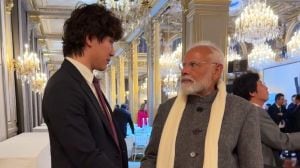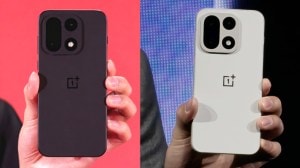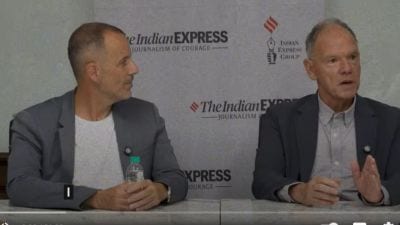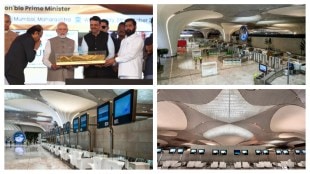As one of the first stylists in India in the late 90s, what is your take on fashion in films today? Can you list any striking aspects of styling that you look at as a custom-couture designer?
As the first stylist in India, I had to learn a lot on the job. I didn’t have any one’s footsteps to follow in, nobody to guide me, which is why I created systems out of my oil, and it slowly led me to an industry that spawned all those systems, however crazy. I still make mood boards for every job I do, and sometimes I have been criticised for that—‘she’s always so artsy and crafty making her mood boards’. But that’s my journey and process.
Costume design happened by chance because people had faith in my ability to do that, and I’m thankful for that. Director Aditya Chopra gave me my first film, Dhoom. I’ve learned along the way that it’s a craft that’s very different and grateful that I get to do different things every day. If you see my show, and Ananya Panday’s looks, in Call Me Bae, it’s an aspirational show for the youth. There’s chaos in the way they dress, her daily days to her Mumbai fun, cool days. So costume design has a lot of thought, but at the same time, it’s very instinctive and what you feel for a character. In the film Cocktail, Deepika’s (Padukone) and Diana’s (Penty) characters were both very different as they played different roles in games from different places. So it’s very important to get the back story, know the narrative and then create the transformative process. I’m a huge admirer of people that do very realistic costumes in film. It’s a craft that is really detailed and unmatched. But I like to bring a little fun to most of my characters.
Most recently, you have styled Isha Ambani for Anant Ambani and Radhika Merchant’s wedding ceremony. You have also styled some of the most enviable Bollywood celebrities like Deepika Padukone, Aishwarya Rai and Katrina Kaif. How is it different to style a celeb or a corporate woman?
I don’t look at any of my clients in categories. If they are celebrities, corporate, or real people, I just look at them as someone who wants to look and feel beautiful and how I can do that to the best of my ability. It’s like someone could be more fussy or like a certain length but it’s my job to make them comfortable and understand those differences. Having said that, even a real person is a celebrity for whatever they stand for. I look more at the occasion that I’m selling the person for—the goal, their look, the appropriateness.
Very often in our country, we don’t have good differentiation on how to dress for occasions. Some come into a wedding or Diwali in exactly the same way. We need to understand that there are nuances and levels of formality, embellishment appropriate for different occasions. I try my level best to make people look right for the occasion, to stand out and be glamorous. Our Chivas show is not about practicality, it’s a celebration of a metamorphosis of style, craftsmanship, creativity, and making luxury tangible, alive, but yet aspirational. So, two very different approaches to work, and I enjoy both and I have a privilege to do both.
Do you adopt an approach to styling the celebs so that clothes don’t claim the limelight of actors from their performances? How much input do your actors/ clients have when it comes to styling their look?
I dig deep into each character. The character is the most important, not the clothes. The clothes need to help establish a character. I am a collaborative person by nature, but I’ve declared my ideas and what I think is right or wrong for a character. So, I would push as hard as I can, but on some occasions if a director or an actor feels differently, then at the end of the day I have to find the right balance. But if a character doesn’t need to be fashionable, it’s not important at all. It’s important to build up a clear world for each person that they belong to whether it’s palette, character’s clothes… all of that.
You are a great supporter of craftsmanship in fashion? Any Indian fashion designer you admire for this work?
I have always promoted home-grown talent, whether it’s fashion designers or photographers, makeup artistes. But I think it’s important to promote that. Until today, with the fashion pop-ups, I do dress people and like to introduce brands that not everybody knows. But it’s important for me to promote the brands that already exist and I establish them as geniuses at what they do. My work combines all this very seamlessly and that’s the world that I like to build and agree with.
Where do you think Indian fashion is headed?
Indian fashion is heading in a complete global direction. I don’t mean that everybody needs to sell internationally, but our fashion is being admired. It has been worn by celebrities all over the world, including India. There was a time when people wore only international designers for big events here in India, whereas now they are proudly wearing Indian designs and that’s a great moment. I feel the biggest stores in the world are recognising our designers and retailing them there. So it’s a great time for me to be part of Indian fashion.
What is non-negotiable for you when you are collaborating with a brand and styling?
For me, I have to genuinely like the product. I feel the quality needs to be of an acceptable standard. And I would imagine a fair amount of creative freedom so that I can get the best of what I believe in.
With Instagram becoming shoppable and influencers becoming a major part of fashion, how important do you think social media is today?
Social media is very important because it has democratised fashion today. Earlier, there were a few people who would write a review. Now, everybody says what they think. It doesn’t mean everybody is right. But it’s nice to kind of hear and you get a sense of what’s working, what people are liking. Also, there’s instant reviews of what people are wearing, whether you like it or not. I don’t always necessarily agree with them, but I enjoy watching them. It’s great to have these voices. I love that creators are able to interpret fashion through their eyes. It’s a great tool and I think it’s helping the fashion industry grow, especially with retail where you can sell directly. So, smaller brands are growing. That’s the same thing that we do now, pop-ups. We see a brand and a pop-up. And then the next thing is they’re opening a store somewhere and it’s just the best feeling in the world. I personally meet and find so many brands on Instagram and I’m very grateful for that.
How has your association with Chivas Alchemy materialised? How do such associations benefit you?
My association with Chivas was very organic. We worked together on an event last year for the Ajio Luxe Wkend. I was there for one of the power talks and a show, which was quite out of the box. That triggered an idea and I was asked if I would be happy to be part of one of the other businesses because who wouldn’t want to be associated with a brand that is associated with legacy, craftsmanship, creativity and even the blend.
When they approached me about the alchemist, my first thought was about how to take that theme of chrysalis and metamorphosis into something new and pathbreaking. That’s what the idea for the show came in. It’s like a gold show, we are using luxury in a tangible way. People will get to be a part of our parade, which is very immersive. It mixes performance with passion. Styling-wise, it’s quite a departure for me, as I am a maximalist by nature. And it’s the enthusiasm and faith, I think, that pushed this idea to be much bigger. It’s great to work with the team at Magnanimous, they gave me wings. I’m going to be the butterfly that’s flying there, and I hope you enjoy the show.









